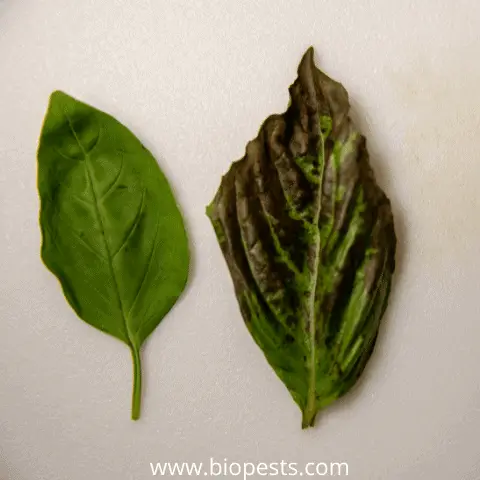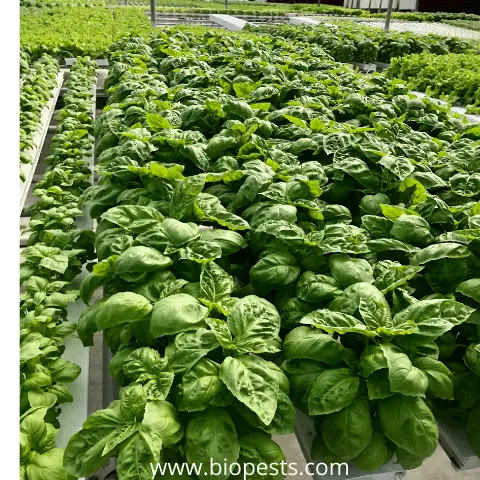Basil is an aromatic herb and is used in cuisines worldwide. Hydroponic basil grows faster than in soil and guarantees a high yield, allowing the farmer to meet the demand and supply high-quality produce. However, hydroponically grown basil faces many challenges, and one of the biggest concerns is the basil wilting.
Hydroponic basil wilts due to lack of nutrients, unfavorable temperature and pH, attack by microorganisms, and high humidity. Solutions to wilting include replenishing the nutrient solution, keeping pH at 5.6-6.6, maintaining the temperature at 65-95°F (18-35°C), using fungicides, and decreasing humidity.
In this article, I’ll discuss in detail why hydroponic basil starts wilting, what you can do once it appears to wilt, and some preventive measures to avoid the problem in the first place.
Causes of Your Hydroponics Basil Wilting
Plants grown in a hydroponics setting are more vulnerable than their soil-grown counterparts. Hydroponics basil is also highly sensitive. That’s why it’s essential first to diagnose the causes of wilting before deciding on a solution.
Lack of Nutrients
In a hydroponics arrangement, water is the only growing medium. The plants get all the nutrients through a nutrient-rich solution applied to their roots. If the water isn’t replenished with nutrients regularly, the plants will become deficient.
Nutrient deficiency is also a contributing factor to basil wilting.
Non-Ideal pH and Temperature Values
The pH and temperature values in a hydroponics system are crucial for two reasons.
- It affects the nutrients’ ability to dissolve into water. Nutrients like calcium and phosphate do not readily dissolve in acidic water.
- It also affects the plants’ ability to absorb nutrients from the water. If the basil plant doesn’t absorb the required nutrients, it won’t grow correctly and wilt in the early stages of growth.
Moreover, if the room temperature of the system is on the higher side, the basil leaves close their stomata to conserve water. However, if the stomata are closed for an extended period, it won’t allow the plant to transpire and gradually wilt.

Attack by Fungus and Pathogens
In a hydroponics system, fungus, pathogens, and other waterborne diseases primarily attack the root system of the plants.
Plants absorb all the nutrients through their roots, and if the core gets damaged, it’ll prevent the plants from getting the nutrients they need, and they’ll eventually die.
Humidity Level
Humidity refers to the amount of water in the air. During the growing period, basil needs to transpire by evaporating water from the leaves.
However, if the atmosphere is already humid, the leaves aren’t able to vaporize excess water. If this condition stays, the leaves will wilt and die in a matter of hours.
4 Solutions for the Hydroponic Basil Wilting
If you have reached the point where you cannot prevent the basil from wilting, you can use the four solutions below to stop the crop from drooping further.
1. Refill Water Solution With Nutrients
If you observe your basil wilting, you should immediately add more nutrients to the water solution. Change your nutrient mix with a mix having a high proportion of nitrogen, potassium, and calcium. These nutrients directly affect the plant’s growth and help the plant recover from the initial stages of wilting.
2. Adjust the pH and Temperature Values
Every plant has a specific requirement of pH and temperature. If your hydroponics basil is wilting even after access to nutrient-rich water, you should check and change the pH and temperature values of the system. The ideal pH level is between 5.6 to 6.6, and the suitable temperature is between 65 and 95°F (18.3 and 35°C).
If you operate a hydroponics system on a commercial scale, you can install an automatic pH controller. However, it’s costly to install and maintain. You can also adjust the pH manually.
To increase the pH, you can use lime or wood ash, and to decrease the pH, you can use citric acid or vinegar. However, plants are sensitive to abrupt pH changes, so you should hire or let an expert do this job.
To change the temperature, you can use fans or coolers to increase the airflow. It’ll help the plants to transpire better.
3. Use Fungicides
Fusarium oxysporum and Verticillium are the two fungi that are known to discolor and wilt plants. If your plant has started to discolor and wilt simultaneously, it’s time you use a fungicide.
The most effective fungicide to counter these fungi is Metalaxyl. It’s a systemic fungicide and is used to stop the spread of many diseases. You can drench the fungicide into the nutrient solution or apply it by foliar.
4. Decrease Humidity
Optimal humidity helps the plants by assisting them in transpiring adequately. During the growing period of basil, the moisture level of the hydroponics system should be between 40% to 60%. If the humidity level is above 70%, it’ll create problems in the transpiring process, and the plant won’t absorb nutrients.
You can use an indoor ventilation system to drive out humid air and keep the flow of fresh air into the system.
How To Prevent Hydroponic Basil From Wilting
When it comes to hydroponic basil, you should always be proactive to prevent the wilting rather than taking corrective measures once the plant starts to wilt.
Apart from the above solutions, it would help if you routinely pruned the basil plants. Plants have to transport nutrients to every corner, and regular pruning will save more nutrients for plants to send to areas that aren’t receiving enough nutrients and will wilt soon.
If you are looking to expand your knowledge on hydroponic vegetable growing, check out this informative article filled with valuable information and tips!
Final Thoughts
The hydroponically grown basil has many benefits if you put in the care and maintenance required. It grows much faster in a hydroponics setting and will give more yield per harvest.
It would be best not to wait for the plants to get damaged and always take preventive measures to counter the potential threats. However, if your plants get affected, don’t panic. Implement the relevant solutions from the ones mentioned, and you should be fine.
Some of the links above are affiliate links, meaning at no additional cost to you, I will earn a commission if you click through and make a purchase.

